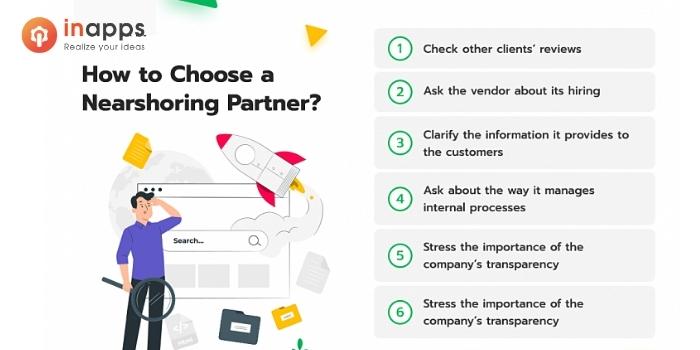- Home
- >
- Offshore News
- >
- What is nearshore outsourcing? Is nearshoring right for you?
In the current climate, companies across the globe are constantly seeking high-quality yet economical software solutions. Often, sourcing these software solutions domestically poses a challenge, pushing organizations to look beyond their borders for the necessary talent. This approach, however, introduces obstacles such as time zone differences, cultural variances, and different management styles, potentially hindering workflow and creating complications.
This is precisely the context in which nearshore outsourcing excels. Nearshore outsourcing is now a top choice as it links organizations to a global talent pool without high costs or complex setups. This method makes teamwork easier with teams in similar time zones and cultures, hence boosting skills, productivity, and cutting costs.
Want to know more about nearshore outsourcing? Read on to see how it can help your business manage costs and tap into a vast talent pool.
1. What is Nearshore Outsourcing?
Nearshore outsourcing (also known as nearshoring) refers to the process of delegating some IT-related work, such as mobile application development, to companies in neighboring countries.
Assume you live in Germany and want to delegate some work that cannot be done in-house to a team from another country. Simultaneously, you’re looking for ways to cut costs but don’t want to deal with time-zone offsets. In this case, you might consider looking for talent in neighboring countries such as Ukraine.

What is nearshore outsourcing?
2. Advantages and Disadvantages of Nearshore Software Outsourcing
2.1 Nearshoring Outsourcing Advantages
Cost-saving
Naturally, there would be no point in outsourcing if there were no cost savings. Using a software company rather than hiring it internally saves money on acquisition, lowers HR costs, and distributes additional charges (including non-IT expenses).
The development of close-shoring software requires you to provide guidance (which is a requirement for all projects), but you do not have to divide the project into multiple teams or assign priorities. Instead, your software outsourcing company can handle the majority of the work. A competent nearshore software outsourcer should have a large, focused staff.
Fewer cultural conflicts
The level of communication efficiency is influenced by factors such as language and cultural background: the fewer the differences, the better. Your staff and the employees of your nearshore software company most likely know English at a high level. However, if you all speak the same language or languages similar to one another, all of the work will be completed more quickly.
The same can be said about cultural similarities. Few people want to postpone a release date simply because the outsourcing partner has days off from national holidays that they do not observe.
Assume you and your nearshore outsourcing provider both speak the same language. Even if you both have excellent English skills, your communication process may be faster and more transparent in this case.
Same time-zone
One thing appears to be simple but is not: time zone. Hiring nearshore development services eliminates time-zone issues that can hinder effective communication. In most cases, a client company and a services-vendor live in the same or nearby time zone, so they are not affected by time differences and can communicate during regular working hours.
This saves you from losing sleep or working on an unusual schedule, but it also allows for collaboration between your internal growth and your external employees.
Faster Integration
One of the significant developments in nearshore outsourcing is a team with similar cultures, a common language, and technical competence that allows the external team to easily integrate into your existing team. Respect for a peer with an equivalent level of technical knowledge increased as coordination and interaction improved, as did the rate at which internal and external resources created a companion company.
As a result, this simplifies the knowledge transmission required to help your external team understand and adapt your procedures and quickly update the information on your application. By accelerating the start-up and knowledge transfer, your nearshore software team may be able to provide value sooner, improve your ROI, and ensure that your target is met.
Enhanced facilities
Improved facilities are another benefit of nearshore outsourcing. You can be confident that the infrastructure is in place because several prominent nearshore software locations are designed to meet your business needs. The choice of a partner in a country with stable internet and communication infrastructure ensures that your project is not delayed due to unforeseen circumstances. This is not a question, but it is essential to consider if your company outsources to other countries.
Best Talents
Nearshore outsourcing gives you access to top-notch talent that might be rare or expensive at home. These places have lots of tech experts, offering skills hard to find in your own country. This makes it easier to boost the quality of your projects and innovations.
Imagine a U.S. company wants to create a new fintech app needing blockchain skills. The U.S. has great talent but finding and affording blockchain experts can be tough. Instead, they look to Mexico or Colombia, where tech skills, especially in blockchain, are booming and less costly. By choosing nearshore outsourcing, they get the expertise needed to make their project a success, tapping into innovations that might be harder or pricier to find at home.
Some Southeast Asian countries are great for software outsourcing, such as Vietnam and Malaysia. Furthermore, due to the State’s policy of retaining and training young resources – enthusiasm and passion – they have a team of nearshore outsourcing teams that can be far superior to other countries in the same industry.
Read more: Top 5 countries that are best for software outsourcing in Asia
2.2 Disadvantages of nearshore outsourcing
Language Barriers and Cultural Differences
While often perceived as a minor challenge, language barriers and cultural nuances can occasionally complicate the smooth flow of communication in nearshore outsourcing relationships. It’s important to note, however, that this challenge can be resolved. Many neighboring countries share similar cultural values, which can facilitate a more agile working relationship. Effective communication strategies and understanding can bridge these gaps, ensuring teams remain synchronized and efficient.
Comparatively Smaller Talent Pool
Regarding nearshoring software development, the available talent pool is indeed broader than what you might find domestically (onshore outsourcing). Yet, it doesn’t quite match the vast reservoir of professionals accessible through offshore outsourcing. This doesn’t diminish the quality of talent available nearshore but highlights a limitation in quantity and possibly in niche areas of expertise.
Operational Convenience
There are certain logistical challenges when managing teams across borders, even with nearshore setups. In software development outsourcing, scenarios requiring quick turnarounds, like software deployments or critical bug fixes, can spotlight these challenges.
Proximity does offer advantages in terms of similar working hours, but it doesn’t eliminate the need for coordination and rapid response. Organizations have found workarounds through innovative solutions like rotating on-call schedules. Such solutions can reduce some of these issues and promote a smoother operational flow.
3. Nearshore vs. onshore vs. offshore outsourcing differences
It’s crucial to know the difference between onshore, nearshore, and offshore outsourcing: it’s basically about finding the sweet spot for your budget without compromising on the work quality you need.
Each has its cost and convenience trade-offs, and understanding these can shape how efficiently you reach your destination, or in business terms, your project goals.
| Outsourcing Type | Definition | Benefits | Drawbacks |
|---|---|---|---|
| Onshore | Outsourcing work to a company or professionals within the same country. | – Cultural and linguistic alignment
– Easier collaboration due to no time zone differences – Simpler legal framework |
– Higher costs compared to nearshore and offshore options due to similar economic conditions |
| Nearshore | Delegating tasks to companies or professionals in neighboring countries, often in similar time zones. | – Better cost efficiencies than onshore
– Cultural and linguistic affinities – Easier travel for in-person meetings |
– May be more expensive than offshore options
– Smaller talent pool compared to offshore |
| Offshore | Contracting works out to far-off countries, usually across different time zones or continents. | – Lower operational and labor costs
– Access to a vast talent pool – Ability to run operations around the clock |
– Cultural and linguistic differences can be challenging
– Coordinating across time zones requires effective management |
Read more: What’s the Difference between Onshore vs Nearshore vs Offshore?
4. How to choose the best Nearshore software company

Nearshore outsourcing companies
Nearshore outsourcing companies can help organizations in outsourcing provide quality service at a lower cost while also facilitating the adoption of the organization’s business processes and protocols that their in-house team uses.
Before hiring nearshore outsourcing personnel to supplement your in-house team, you must conduct extensive research. Consider a company’s location, its country’s economy and laws, and its developers’ level of training and experience. There is no right or wrong answer here; it all depends on your business goals, the amount of money you have to spend on a project, and your overall vision of future collaboration with a team you want to hire.
Good luck with finding the right nearshore outsourcing company for your project. If you want to check out offshore development to compare, here’s an article you may be interested: The Ultimate Guide to Offshore Software Development and Best Practices.
Let’s create the next big thing together!
Coming together is a beginning. Keeping together is progress. Working together is success.




















